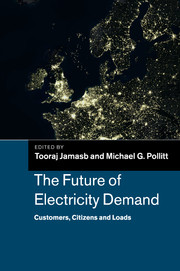Introduction and overview of the chapters
Published online by Cambridge University Press: 05 March 2014
Summary
Opening remarks
This book aiMS to explore aspects of the future demand for electricity in the light of the challenges posed by climate change. In the UK we have a formal target for the reduction of carbon dioxide equivalent emissions of 80 per cent by 2050 (on 1990 levels). Official publications regularly suggest that reducing overall energy demand is an important part of meeting that target. Indeed, in a recent report of the UK Committee on Climate Change (CCC, 2009, p. 22), it was suggested that residential energy efficiency measures could reduce carbon dioxide emissions by 50 million tonnes per annum (or around 10 per cent of the UK's current total emissions) by 2022. The UK is not alone: many other countries have targets and aspirations for the reduction of energy consumption. Meanwhile, the future of energy demand will increasingly be synonymous with the future of electricity demand if the heat and transport sectors are electrified over the coming decades.
Decarbonization of the energy sector is not just about reducing energy demand. Emissions from direct combustion of heat and direct combustion of liquid fuel in vehicles are roughly equal to emissions from power stations. Reducing emissions from electricity production is technically feasible via a combination of renewables, nuclear power and carbon-capture-and-storage equipment. This implies that switching heating and transportation demand for energy from combustion of fossil fuels to heat from electricity (or combined heat and power) and to electric vehicles is important in reducing emissions.
- Type
- Chapter
- Information
- The Future of Electricity DemandCustomers, Citizens and Loads, pp. 1 - 14Publisher: Cambridge University PressPrint publication year: 2011



